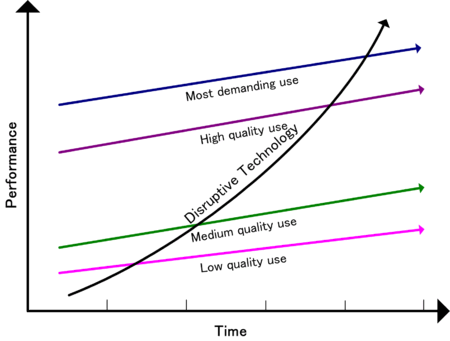(9AM EST – promoted by Nightprowlkitty)
Technology is a double-edged sword.
It can spark the furnace, that keeps you alive in the winter.
It can spark a wild fire, that consumes all its path.
But then again, Lightning can cause the same damage —
WITHOUT the assist of human innovation.
Technology is a double-edged sword.
It can lead to increased crop production, to feed the masses;
which in turn, can lead to increased masses,
that taxes that same crop production.
Technology is a double-edged sword.
Sometimes the simplest of inventions —
can change the world;
often in ways, never imagined by the inventors.
Such innovations have been call “Disruptive Technology” —
because their impact, is SO unexpected,
and yet SO useful — that they spin off other innovations,
and industries, and businesses, and even
entirely new ‘ways of life’ …

“Disruptive Technologies” often cross-cut the existing Technology solutions —
usually in terms of increased benefits, at an equal or lower price.

If the early “adoption rate” is rapid — Disruptive Technologies can even completely replace the competing products that preceded them, and a few marketing breaks, and popular buy-in.
Disruptive Innovation Displaced or Marginalized technology Compact Disc Gramophone record and Magnetic tape Downloadable Digital Media CDs, DVDs Desktop publishing Traditional publishing Digital photography chemical photography Light-emitting diodes Light bulbs Telephones Telegraphy Refrigerators Ice houses Paper Parchment
No doubt you can think of many more, similar Technology ‘Disruptions’.
In the PC Tech arena alone, the innovations are legend, in short they have been “world-shaping”:
The 10 Most Disruptive Technology Combinations
Dan Tynan, PC World — Mar 18, 2008
The 10 Most Disruptive Technology Combinations
10. DVRs + Entertainment on Demand
9. YouTube + Cheap Digital Cameras and Camcorders
8. Open Source + Web Tools
7. MP3 + Napster
6. Blogs + Google Ads
5. Cheap Storage + Portable Memory
4. Cloud Computing + Always-On Devices
3. Broadband + Wireless Networks
2. The Web + The Graphical Browser
1. Cell Phones + Wireless Internet Access
Gee-whiz? … Blogging and Websites have changed the world — Who Knew?
Even though Innovation and Invention, are a givens of the Human spirit — Sometimes, the most world-shaking Innovations, will fall quietly by the wayside. Often the victim of bad luck and poor timing. Often shelved away, for more nefarious anti-completive reasons.
And we as the Human Species, are much the poorer for it.
If ‘Raising a Child — takes a Village’, as Hillary Clinton wrote about — then saving “Humanity” itself — may eventually “take” the combined creativity and innovations, of ALL of us — if we are to ever reach our ultimate potential?
Nevertheless, the pace of progress plods on, and given enough of a widespread necessity, and equivalent matching opportunities, to meet that need — and IF it is cost-effective enough to do so. Sometimes.progress.happens.
Technology is a two-edged sword. It’s both weapon and a tool.
Both a Threat and an Opportunity.
[A Threat to established products niches; an Opportunity for improved Quality of Life, for yet even more people.]
However, having simply “better quality” and “better features” does not always mean, we will see those improvements on our shelves, anytime soon — Corporate Inertia being what it is and all.
And sometimes, it’s just that ‘synergistic spark’, is simply missing from the product early adoption efforts.
Disruptive technologies are not always disruptive to customers, and often take a long time before they are significantly disruptive to established companies. They are often difficult to recognize. Indeed, as Christensen points out and studies have shown, it is often entirely rational for incumbent companies to ignore disruptive innovations […]
Even if a disruptive innovation is recognized, existing businesses are often reluctant to take advantage of it, since it would involve competing with their existing (and more profitable) technological approach.
And what does the “coiner” of the term, have to say about this ‘innovative resistance’?
[Harvard Business School professor Clayton M.] Christensen demonstrates how it is not unusual for a big corporation to dismiss the value of a disruptive technology because it does not reinforce current company goals, only to be blindsided as the technology matures, gains a larger audience and marketshare, and threatens the status quo.
Established Product Niches, by their nature, show a lot of resistance to Change. They are making their millions with the Status Quo, so they often ask: Why Innovate?
[Sidenote: It’s really too bad, we don’t have a National Department of Innovative Product Development … to counteract this Negative Inertia — the instinct to “stay the same”. The journey of a thousand miles, sometimes takes a “little push” to get moving …]

Given that Corporate Inertia is what it is — it’s usually very difficult for NEW innovative products, to break through the “known solutions” clutter … to establish a new market niche … to catch fire as the “next must-have device or service”. Yet small business owners will continue to try …
Disruptive Technologies could really use a little help getting off the ground.
Far too many good ideas, go fallow, for lack of funding or vocal enough advocate-sponsors.
Happily, this missing “seed money” situation, may be changing for Clean Energy for the 21st century … this ‘Disruptive’ R&D, by the best and the brightest, are NOW being funded, thanks the Recovery Act , at the Dept of Energy (DOE):
Basic Energy Sciences’ Energy Frontier Research Centers page
Energy Frontier Research Centers
[…] Important as they are, incremental advances in current energy technologies will not be sufficient. History has demonstrated that radically new technologies arise from disruptive advances at the science frontiers. The Energy Frontier Research Centers program aims to accelerate such transformative discovery, combining the talents and creativity of our national scientific workforce with a powerful new generation of tools for penetrating, understanding, and manipulating matter on the atomic and molecular scales.
[…]In August 2009, the Office of Basic Energy Sciences in the U.S. Department of Energy’s Office of Science established 46 Energy Frontier Research Centers (EFRCs). These Centers involve universities, national laboratories, nonprofit organizations, and for-profit firms, singly or in partnerships, and were selected by scientific peer review and funded at $2-5 million per year for a 5-year initial award period.
[…]The EFRCs will harness the most basic and advanced discovery research in a concerted effort to establish the scientific foundation for a fundamentally new U.S. energy economy. The outcome will decisively enhance U.S. energy security and protect the global environment in the century ahead.
And that R&D “seed money” — is beginning to bear fruit, according to recent Science headlines.
These meager Investments in our Future, are producing Innovations, that hold the promise of one day TOTALLY changing the Energy world — given the appropriate Business Sponsorship, and Product Development efforts, of course …
Revolutionary Glitter-Sized Solar Photovoltaics
by Ehud Rattner, The Future of Things — March 02, 2010
Sandia National Laboratories, New Mexico, has recently developed tiny glitter-sized photovoltaic cells, which could revolutionize applications of solar energy. The new development, which has the capability to produce more energy at lower costs, could lead to future utilizations of the sun, creating a cleaner, safer environment.
[…] Since the researchers expect these particles to be cheaper and more efficient than current photovoltaic collectors, they estimate that the research will get the attention of many firms at the solar-energy industry.
The research’s lead investigator, Greg Nielson from Sandia National Laboratories, said his team has identified more than 20 benefits of scale for its micro-photovoltaic cells. These include new applications, improved performance, potential for reduced costs and higher efficiencies. “Eventually units could be mass-produced and wrapped around unusual shapes for building-integrated solar, tents and maybe even clothing,” he said.
Sandia field engineer, Vipin Gupta, added: “Photovoltaic modules made from these micro-sized cells for the rooftops of homes and warehouses could have intelligent controls, inverters and even storage built in at the chip level.”
[…]
The new development could benefit large-scale power generation as well. Murat Okandan, a member of the team, said: “One of the biggest scale benefits is a significant reduction in manufacturing and installation costs compared with current PV techniques.” Moreover, manufacturers could enjoy lower costs; this is because microcells require relatively little material to form well-controlled and highly efficient devices.Additional benefit is the cells’ flexibility – they could be made from almost any wafer, because they are only hundreds of micrometers in diameter.
[…]
Although the team is already considering moving their development to the commercial stage, the possible applications are yet to be designed and manufactured.
Cheap affordable, solar energy fabrics, with built in storage, and flexible enough to form-fit any surface —
Unbelievable! Impossible? Impratical …
Then again maybe not — in order to light that must-have fire, it would only take the right Business sparks … and perhaps a Vision of what the Future should be. And a little more Future Tech investments, to make the Possibilities of NanoTech, come to life …

The incredible shrinking solar cell
With lilliputian collectors, almost anything could be sun-powered
By Janet Raloff
ScienceNews, Vol.178 #3 — July 31st, 2010
“The idea is to develop ubiquitous solar power,” says Greg Nielson of Sandia National Laboratories in Albuquerque. Foldable and moldable modules crammed full of photovoltaic cells could directly power devices or recharge batteries. “You can imagine putting them onto every surface,” he says. “Your cell phone, laptop, backpack, tent – whatever.”
The U.S. Department of Energy is funding more than a dozen labs to investigate photovoltaic physics “at the nanoscale,” notes Linda Horton, who works in the agency’s Office of Science in Washington, D.C. “Our goal,” she says, “is to understand and improve at a very fundamental level the process by which energy from sunlight is translated into electrical energy.”
[…]The Sandia program, which began in early 2008, is already turning out prototype cells with an energy conversion efficiency of about 15 percent. “And we anticipate getting over 20 percent,” Nielson says. That wouldn’t be far from the best commercial solar cells today, which sport efficiencies somewhat more than 25 percent, Okandan adds.
The small print
At the University of Illinois at Urbana-Champaign, John Rogers works with even thinner silicon – 10 to 15 micrometers thick – because when it’s slim enough it flexes like a strand of hair.
[…]Prospects
Although none of the emerging designs are quite ready for prime time, several groups think that products based on their innovations could enter the marketplace in as little as three to five years.
“Right now the solar industry is kind of in a race to bring costs down to $1 per watt,” Nielson says. “From our cost models, it looks like we can get well below that with high-volume production.” But that’s a ways off, he concedes, since his team has only just begun networking individual glitter cells to make coordinated modules.

Efficient Solar, with Printable Fabric costing “only $1 per watt” —
available in “in as little as three to five years” ??
Innovative surfaces that hold the potential of “directly recharging batteries” ??
Well giddy up! [as Kramer would say]
Below are some MORE similar Nano-scale Solar Tech R&D Projects which are also being funded [Yeah!] by the much-maligned Recovery Act — this is what “getting moving” is all about …
DOE dishes out $377 million for new Energy Frontier Research Centers
By Tom Cheyney — 07 August 2009
The delivery of $377 million in combined Recovery Act and U.S. Department of Energy funding for a network of new multimillion-dollar Energy Frontier Research Centers (EFRCs) first announced in April has taken place. The 46 centers, many of which will focus on solar photovoltaic-related materials and other research, are located at universities, national labs, nonprofit organizations, and private firms in 22 states (including seven in California) and the District of Columbia.
— University of California, Santa Barbara (Santa Barbara, CA): $19 million for five years to discover and develop materials that control the interactions between light, electricity, and heat at the nanoscale for improved solar energy conversion, solid-state lighting, and conversion of heat into electricity.
— Columbia University (New York, NY): $16 million for five years to develop the enabling science needed to realize breakthroughs in the efficient conversion of sunlight into electricity in nanometer-sized thin films.
— University of Michigan (Ann Arbor, MI): $19.5 million for five years to study complex material structures on the nanoscale to identify key features for their potential use as materials to convert solar energy and heat to electricity.
— University of North Carolina (Chapel Hill, NC): $17.5 million for five years to synthesize new molecular catalysts and light absorbers and integrate them into nanoscale architectures for improved generation of fuels and electricity from sunlight.
For a complete list of the 46 EFRCs (Energy Frontier Research Centers), their lead institutions, funding levels and objectives, check out this DOE Link.
ALL that recurring Disruptive “seed money” is a GREAT start — one the GOP would shelve in an instant, given the opportunity — they are the “Anti-Innovation Party” if you ask me …
BUT as an Al-Gore-Progressive, myself — I will always want MORE such Innovative investments. Because as our esteemed former Vice President put it:
Gore cited an African proverb that said,
“If you want to go quickly, go alone. If you want to go far, go together.”
Our challenge, he added, is that we need to do both: go far and go quickly.
The world’s businesses can help with that challenge by realizing that sustainability is not only an increasing concern among customers, but also good economic sense, Gore continued.
“There are multiple reasons why business leaders who focus on sustainability are better off in many different respects,” he said. For one, he noted, pollution – in particular, greenhouse gas pollution – is waste. The more businesses can reduce waste, the better off their bottom lines, he said.
“Carbon dioxide is a marker of business inefficiency,” he said.
Al Gore: Information tech is key to a sustainable future
By Greenbang on Monday, May 17, 2010
Daylight is a burning. We aren’t getting an younger.
Business-as-Usual is NOT getting us any more “efficient” either.
The Clean Energy roads ahead, will not getting any easier, the longer we wait —
But Luckily for us (or perhaps it’s just our curse ? ) …
We still HAVE Technology
that double-edged sword … which has embodied within it,
both awesome Promise … and significant Perils.
The Promise of fantastic, creative innovations of human ingenuity,
The Perils of simply putting those same innovations, on a shelf —
… as if they never existed;
… as if WE never had a chance, to shape the world, for the better.



8 comments
Skip to comment form
Author
from a group that tracks this
SolarBuzz
Solar Module Price Highlights: July 2010
provides all the power you need that you never have to look at.
Richard Hoagland
Eugene Mallove, Philio T Farnsworth, Dennis Kuchinich space preservation acts 1 and the watered down second one deleting the mention of chemtrails, mind control via electromagnetic signals, S517 The Weather Modification Act and let’s throw in the Hutchinson effect for total tin foil hat coverage.
Michael Schratt does classified aircraft and Joeseph Farrell knows the Nazi scientists from WWII. Michael Tellinger studies ancient civilizations but Sarbanes-Oxley did corporate IP too. It’s all a big secret now.
One of the rarely discussed issues is how / whether disruptive potential is constraining deployment of better energy systems.
“Wow, look at what will be here tomorrow, why buy this today” is a logical reaction to news stories like those in this piece
Personally, I think that this might be better as (at least) three distinct pieces (even if linked):
1. Disruptive technology — with reference to the DOE program.
2. The DOE program.
3. The solar developments.
By the way, saw Secretary Chu speak last evening (
http://getenergysmartnow.com/2… One of the things that he emphasized was the importance / value of gov’t investment to tip the balance to move things along the innovation process — from the lab to use in everyday life. And, that much of the targeted investment within in DOE is focused on this.
One of the rarely discussed issues is how / whether disruptive potential is constraining deployment of better energy systems.
“Wow, look at what will be here tomorrow, why buy this today” is a logical reaction to news stories like those in this piece
Personally, I think that this might be better as (at least) three distinct pieces (even if linked):
1. Disruptive technology — with reference to the DOE program.
2. The DOE program.
3. The solar developments.
By the way, saw Secretary Chu speak last evening (
http://getenergysmartnow.com/2… One of the things that he emphasized was the importance / value of gov’t investment to tip the balance to move things along the innovation process — from the lab to use in everyday life. And, that much of the targeted investment within in DOE is focused on this.
Mind a cross-post?